Creepy crawling creatures on crops are familiar during the spring and early summer seasons. Horned caterpillars are examples of these crawling insects that are larvae of moths and butterflies.
Hornworms can defoliate plants since they chew leaves and make holes in the fruits. Horned caterpillars cannot bite or sting; we recommend removing them physically to manage their infestations.
Horned caterpillar examples are tomato hornworms, dragon-headed caterpillars, and the hickory horned devil. Other types of horned caterpillars are orange striped oakworm, monarch caterpillars, and tobacco hornworms.
Identifying horned caterpillars may sound simple, but you need to know a thing or two for easy differentiation. Some wild hornworms collect and store toxins in the plants they feed on, making them poisonous to pets if ingested.
How to Identify Horned Caterpillars
All caterpillar species belong to the insect order Lepidoptera. These creepy crawling creatures start as eggs before developing into a larva that look-like a fat worm. These caterpillars are destructive since they are voracious eaters.
Caterpillars enter the pupal stage before turning into moths or butterflies. Identifying different types of horned caterpillars is a no-brainer task. Below are the features or structures that help identify and classify these hornworms:
Horns
These caterpillars have spiny structures on their tail or head that look like horns. They use these horns for defense by warding off potential predators.
Some horned caterpillar types use these spiny structures to frighten other animals by wagging them. Most horned caterpillars are not types of stinging caterpillars.
Body Markings
Horned caterpillars can be hairy, furry, or striped and black, green, yellow, or multi-colored. Green caterpillars are the most common types of horned caterpillars.
Types of Plants They Feed On
Horned caterpillars feed on different types of plants since some species feed on tomato leaves or fruits and others on hickory tree leaves. These crawling creatures can also defoliate any plant.
Different Types of Horned Caterpillars
Let us now look at different kinds of horned caterpillars with their pictures, description, and scientific names. The information will help you identify horned caterpillar species in your garden or backyard.
White-Marked Tussock Furry Horned Caterpillar
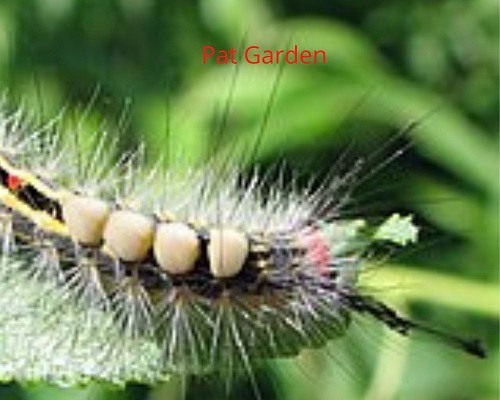
These furry-horned caterpillars are native to North America (Texas, Florida, and Alberta in Canada). They have black bodies and tufts of white hair with red dots and yellow stripes on their back.
These scary-looking caterpillars have two large hairy antennae on their heads. Some species have a large furry-looking tail for wagging off potential predators. The two long horns and furry tail are the identification features.
| Scientific Name | Orgyia leucostigma |
| Host Plants | Apple, Birch, Oak, Black Locust, Cherry Elm, and Hackberry. |
| Body Appearance | Black body with tufts of white hairs. Some have red dots and yellow stripes on their backs. |
| Identification Features | Two long hair horns and a large furry tail pointing upwards. |
| What They Turn Into | White-marked tussock moth |
Zebra Longwing Caterpillar with Horns
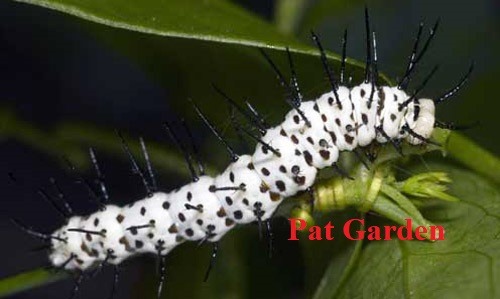
The caterpillar species hails from Texas, Florida, and Central America. These creepy crawling creatures have sharp-looking horns sticking out in all directions. They also have light-colored gray to white bodies.
The six rows of long spines, tiny jagged spikes, and black dots are the leading prominent features of Zebra longwing caterpillars with horns. They feed on passionflower family plants. (Source: University of Florida).
| Scientific Name | Heliconius charithonia |
| Host Plants | Passionflower family |
| Body Appearance | Light gray or turquoise green |
| Identification Features | Black sharp-looking horns |
| What They Turn Into | Zebra longwing butterfly |
White-Lined Sphinx Horned Caterpillar
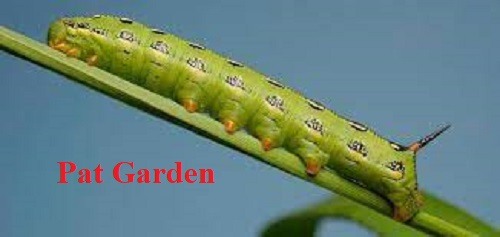
This caterpillar species has a protruding tail horn common in many green caterpillar species. It also comes in a lot of color variations with horns on its end.
Some species have smooth black bodies with lines of orange dots. Others have lime-green bodies with multicolored dots-like red, yellow, or black.
White-lined sphinx horned caterpillars have yellow-orange prolegs under the middle segment of their bodies.
| Scientific Name | Hyles lineata |
| Host Plants | Cardinal flower, evening primrose, honeysuckle, Jimson weed, and lilac. |
| Body Appearance | Smooth black bodies with lines of orange dots. |
| Identification Features | Orange horn on its back and spiky-looking protrusion. |
| What They Turn Into | White-lined Sphinx moth |
Oleander Hawk Moth Caterpillar
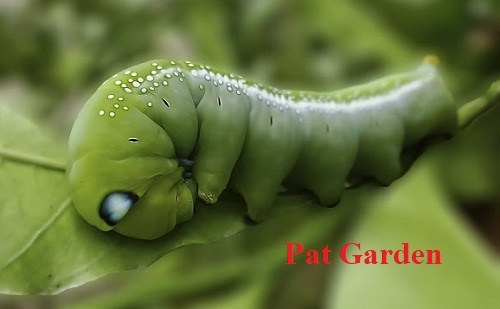
It is a type of green caterpillar with a spiky horny tail. This caterpillar species also resembles tomato or tobacco hornworms.
These caterpillars have green bodies with distinctive eye-markings that bring a haunting appearance. The middle segments have fat and large prolegs.
The pale bluish lines and dots on the sides are the prominent features of identifying oleander hawk caterpillars.
| Scientific Name | Daphnis nerii |
| Host Plants | Vitis, Vinca, Gardenia, Alstonia, Carissa, and Asclepias. |
| Body Appearance | Green bodies with pale buish lines and bluish dots |
| Identification Features | Large prolegs in the middle segments |
| What They Turn Into | Oleander hawk-moth |
Elephant Hawk Moth Caterpillar
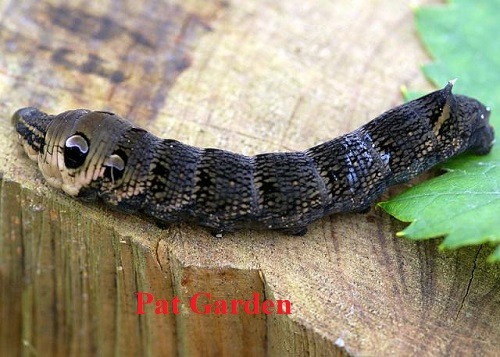
The caterpillar species has a fat gray body with an elephant trunk appearance. Mature larvae can reach 3-inches with brown-gray color and black dots along the sides.
Some caterpillar species have dark green bodies with a small black or gray spike on their tails. Elephant hawk caterpillars are native to Europe and North America.
| Scientific Name | Deilephila elpenor |
| Host Plants | Willowherb, Bedstraw, Grapevine, and Loosestrife |
| Body Appearance | Fat gray body |
| Identification Features | The small curving horn on the tail segment |
| What They Turn Into | Elephant Hawk Moth |
Saddleback Horned Caterpillar
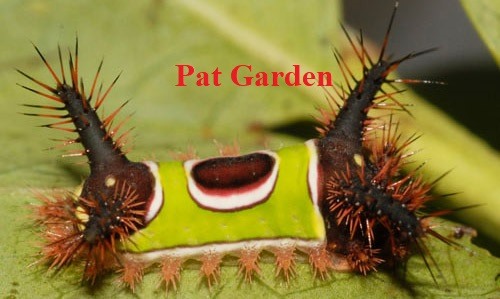
Saddleback horned caterpillars are types of stinging toxic caterpillar species. They are known to give nasty bites when touched with unprotected hands.
These caterpillars have a menacing appearance due to the plethora of horns. The pair of thick horns on both ends and hairs can cause skin irritation when brushed against.
The brown spiky body and lime green square patch on the back is the conspicuous feature of the saddleback horned caterpillar.
| Scientific Name | Acharia stimulea |
| Host Plants | Apple, Aster, Citrus, Blueberries, Corn, Elms, Grapes, and Dogwoods. |
| Body Appearance | Lime-green square patch on the back |
| Identification Features | Four large spiky horns on the head and tail |
| What They Turn Into | Saddleback Moth |
Blue Swallowtail Caterpillar
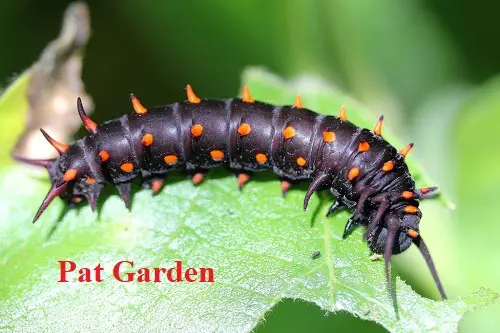
It is also called pipevine swallowtail caterpillar since the caterpillar species have horns stinking all over it. Pipevine caterpillars come in different colors and body textures.
The blue swallowtail caterpillar has long protruding tubercles at the end of its back and shorter horns sticking out on its sides.
The row of soft horns and velvety body appearance are crucial features for identifying blue swallowtail caterpillars.
| Scientific Name | Battus philenor |
| Host Plants | Celery, Carrot, Spicebush, and Milkweed. |
| Body Appearance | Glossy velvety appearance |
| Identification Features | A row of soft horns |
| What They Turn Into | Blue Swallowtail Butterfly |
Dragon-Headed Caterpillar
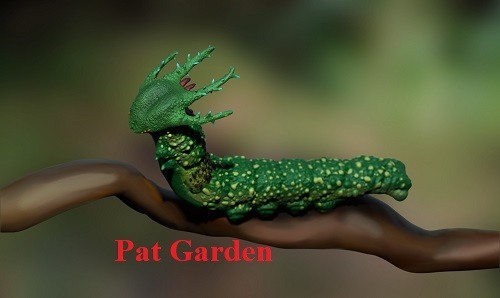
It is a long green slug with four horns on its head. The caterpillar species has a mythical dragon look, although it is harmless and does not sting.
These green-horned caterpillars are native to Indonesia and central Asia. A dragon-headed caterpillar turns into a brown chocolate-colored winged butterfly.
The lateral creamy white stripes on the middle segments are the features that set these dark green caterpillars apart.
| Scientific Name | Polyura athamas |
| Host Plants | Kurrajongs and certain legumes |
| Body Appearance | Dark green bodies |
| Identification Features | Two horns on either side of its head |
| What They Turn Into | Nawab butterfly |
Rustic Sphinx Caterpillar
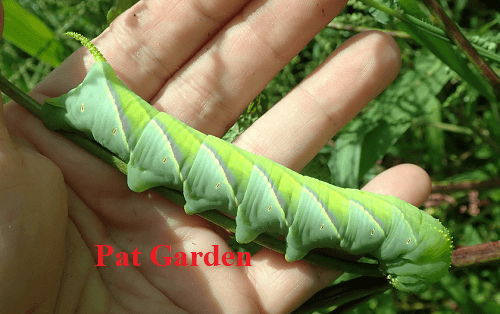
Rustic sphinx caterpillars have sharp-looking and dark green horned tails. These caterpillar species are related to hornworms and other sphinx caterpillars.
The bright-green body with small orange-red dots on each segment and tiny black dots in between segments are the prominent features.
| Scientific Name | Manduca rustica |
| Host Plants | Fringe-tree, jasmine, and bignonia |
| Body Appearance | Bright green with small orange-red dots and black dots between segments. |
| Identification Features | Granular bumps on its rear horns |
| What They Turn Into | Rustic sphinx moth |
Orange Striped Oakworm
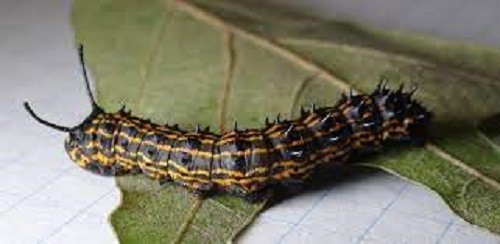
It is a type of stripy black caterpillar with horns and tiny spikes. The orange stripes run along its length.
Orange striped oak worm caterpillar is harmless despite having sharp protruding horns on its head. The caterpillar species feeds on oak tree leaves.
These caterpillar species hail from Florida, Texas, and other southern states in the United States. Orange striped caterpillars turn into beautiful orange and pink months.
| Scientific Name | Anisota senatoria |
| Host Plants | Oak trees |
| Body Appearance | Black body with orange stripes |
| Identification Features | The spiky rear end, long horns, and orange stripes |
| What They Turn Into | Orange-striped oakworm moth |
White Admiral Caterpillar
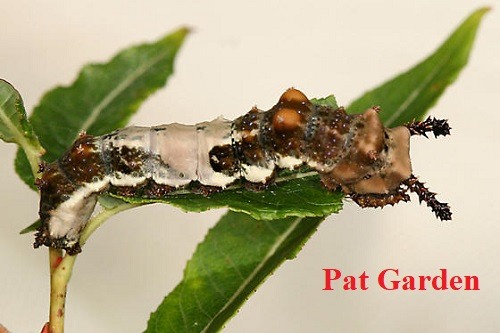
White admiral caterpillar species are native to North America and come with two long spiky black horns on each end.
The caterpillar species has brown and white patchy markings those look-like bird droppings on a tree branch. These caterpillars feed on birch, willow, and cherry leaves.
White admiral caterpillars turn into beautiful butterflies with blue iridescent colors after passing through the pupal stage.
| Scientific Name | Limenitis arthemis |
| Host Plants | Carolina willow, Cottonwood, wild cherry, and black oaks. |
| Body Appearance | Olive-brown and white body |
| Identification Features | Two twig-like horns |
| What They Turn Into | White admiral butterfly |
Rosy Maple Caterpillar

Rosy maple moth caterpillars dwell on all types of maple trees since they feed on the foliages. They are also called green-striped mapleworms.
The two jet-black horns on the head are the most conspicuous features of green-striped mapleworms. The fat slug caterpillar also has greenish-white stripes along its length.
The caterpillar’s body colors are vulnerable to changes due to different larvae growth stages. The black dots running along its length are also crucial during identification.
| Scientific Name | Dryocampa rubicunda caterpillar |
| Host Plants | Sugar maple, silver maple, turkey oak, and red maple. |
| Body Appearance | Greenish-white stripes |
| Identification Features | Black dots and light-colored striped body |
| What They Turn Into | Rosy Maple Moth |
Hickory Horned Devil
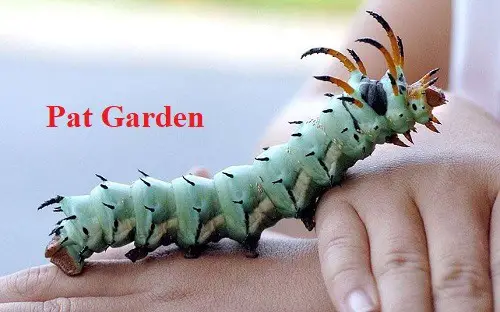
The devil-like appearance makes this caterpillar species intimidating. These turquoise-green caterpillars have large red jagged curved horns on their heads and smaller black horns on each segment.
Hickory-horned devil caterpillars are placid and harmless. These creepy crawling creatures love gorging on hickory leaves, cotton, and hazel leaves. A mature hickory horned devil caterpillar turns into a regal moth after passing through the pupa stage.
| Scientific Name | Citheronia regalis |
| Host Plants | Walnut, butternut, and hickories |
| Body Appearance | Black spines |
| Identification Features | Large red and black horns |
| What They Turn Into | Regal Moth |
Monarch Caterpillar
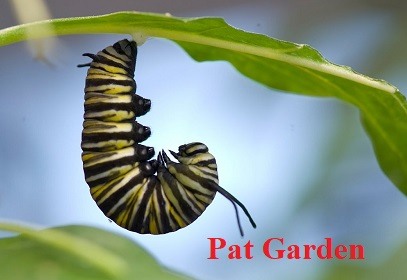
Monarch caterpillars have two pair of horns on both ends with black, white, and yellow markings wrapping their bodies. These caterpillar species are harmless and do not bite.
The two head horns are longer than the two tail horns. These caterpillar species love gorging on milkweeds.
| Scientific Name | Danaus plexippus |
| Host Plants | Milkweed Plants |
| Body Appearance | White, black, and yellow bands around each segment. |
| Identification Features | Two longer horns at one end and two short horns at the other end. |
| What They Turn Into | Monarch Butterfly |
Tobacco Hornworm
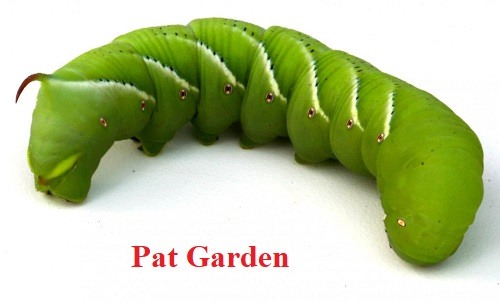
A tobacco hornworm has a single horn-like tail with plump segmented bodies. The oversized head and eye-like markings are key features for identification.
These annoying caterpillars feed on tomato plants and eggplant leaves. They resemble tomato hornworms though the thin diagonal stripes are conspicuous.
| Scientific Name | Manduca sexta |
| Host Plants | Coyote tobacco, sacred datura, and tomato. |
| Body Appearance | Big green luminous |
| Identification Features | Thin diagonal stripes on each segment |
| What They Turn Into | Hawk Moth |
Tomato Hornworm
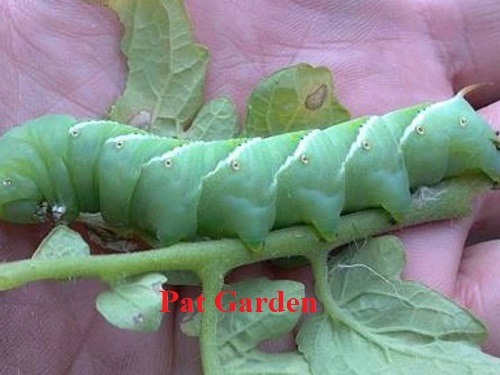
It is a lime-green caterpillar species with a horned tail. The caterpillar type feeds on tomato leaves and makes holes in the fruits.
The cream-colored markings and eye-like markings usually help to confuse potential predators. It is one of the largest caterpillar species in the world.
These caterpillars are non-poisonous, and their tails do not sting. We recommend picking them from the tomato leaves to prevent defoliation. (Sources: University of Minnesota).
| Scientific Name | Manduca quinquemaculata |
| Host Plants | Tomato leaves |
| Body Appearance | Lime-green |
| Identification Features | |
| What They Turn Into | Five-spotted hawk moth |
My Final Thoughts
Caterpillars are the larval stage of moths and butterflies. Some of these crawling insects have horns for defense or to frighten potential predators. These spiky-looking structures give caterpillars a horned appearance.
Examples of horned caterpillars are tomato hornworm, dragon-headed caterpillars, hickory horned devil caterpillar, and more. We hope the pictures, scientific names, and descriptions will help you identify these horned caterpillars.
Readers Who Read This Also Read: